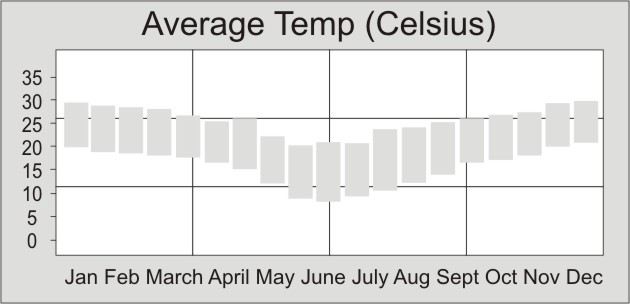Climate & Geography of Namibia


The Average Annual Temperature and Rainfall in Namibia as measured in Windhoek
Geography
From a travelers point of view the fact that Namibia has arguably the lowest population density in the world is quite an advantage. As with everywhere else in the world it is burgeoning human populations that threaten natural integrity, and limit the scope of free range travel anywhere. In Namibia the overland travel ethos is alive and well, and the vast desert hinterland that makes up so much of the country is ideal for disappearing into the back country with a 4×4 and rubbing shoulders with not another soul for hundreds of square miles.
Namibia is overwhelmingly a desert landscape, but more than this it is a quintessential desert landscape, with the signature red dues of the Sossusvlei, the bushveld scrub of Etosha Pan and the bleak dune desert of the Namib.
Namibia consists of a Central Plateau wherein most of the population and economic activity are concentrated, bordered in the northwest by the Skeleton Coast, by the Namib Desert and associated coastal plains to the southwest and the vast Kalahari Desert to the east.
The Skeleton coast, sometimes referred to as a 200km deep beach, is formed mainly of dune desert and gravel plains. The Namib itself is a mixed environment of dune desert, gravel plains and scattered bushveld and is home to the iconic Namib Naukluft National Park. The Kalahari desert is in fact a demi-desert landscape that encompasses vast areas of the region, covering much of Namibia, Botswana and fringing Angola, Zimbabwe and larhe areas of South Africa.
Climate
Climatic zones correspond broadly to these geographic regions. The northeast enjoys a sub-tropical habitat so rainfall is heaviest and most frequent there. The northern and interior regions experience very limited annual rainfall.
Daytime summer temperatures in the Central Plateau region can climb to over 40°C but can conversely plummet to below freezing at night.
Temperatures are much cooler in the northeastern bushveld region along the border with Angola and the Caprivi Strip seldom rising above 30°C.
Mid-year daytime temperatures are cooler throughout and travel during this period is comfortable. This also corresponds with the Âdry season which is most acute between April and November.
One of the climatic anomalies of Namibia is the interaction between the cold, Antarctic Benguela Current that scours the west coast, and the warm landmass of desert itself. This results in frequent and heavy condensation that drifts deep inland and sustains a subdued by reach natural ecology that otherwise would be unable to exist.